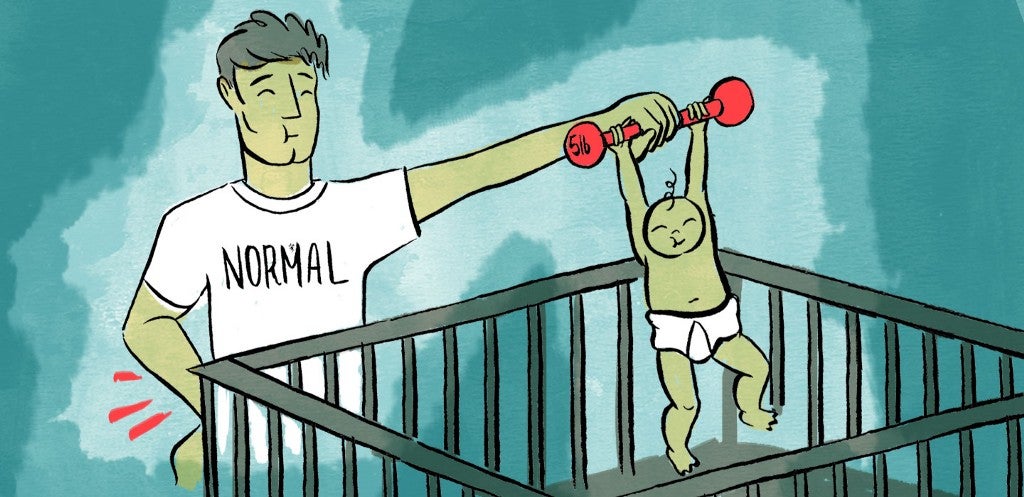Don’t have three hours a day to spend at the gym? Not interested in bulging like a bodybuilder? Unmoved by promises of “fat-blasting, ab-chiseling monster workouts”? This is the column for you, fellow regular human with very little free time.

The Man
Ronald, Bertrange, Luxembourg
Age: 42
Height: 6’1”
Weight: 198 pounds
Goal: Drop 10–15 pounds and stop seeing a chiropractor.
His Time Commitment (Or Lack Thereof): “I’m originally from the Netherlands, but I moved to my wife’s home country of Argentina 10 years ago,” Ronald says. “In Holland, I had some back surgery, but was still in good shape, playing field hockey two or three times a week. Moving to Argentina meant lots of good food, cold beer and great wine. But exercise, not so much. We moved to Luxembourg six years ago, and two years ago we had a son. Between the endless rain of Luxembourg and a busy schedule, I can only find maybe 30 to 45 minutes per day to work out. I could, though, try to do something during lunchtime, as we have facilities in the office.”
Exercise He’s Actually Willing to Do: “I enjoy most types of exercise, although I’m not a big fan of gyms as they seem to function more as a real-life Tinder than a place to work out. I picked up field hockey again, but got another back injury that makes it hard to play. (I get radiating pain in my left shoulder.) I see a chiropractor a few times a year for it; I also did some yoga for it, which helped, but I couldn’t make it fit with my schedule as the yoga studio was far away. Diet-wise, I don’t eat anything that comes out of the water, so no seafood.”
What He Wants: “I’d like to generally feel fitter, lose 10 to 15 pounds, strengthen my hamstrings (so I can go skiing again) and stop having to see the chiro.”

The Plan
Spend Less Time Drinking, More Time Working on Your Core: “With the type of lifestyle you have, and the past injuries under your belt, it’s no surprise your back is bothering you,” says personal trainer Lalo Fuentes. “The good news is that what you have is easy to fix: Your main issue is a weak core, but once you slow it down with the alcohol and moderate your meal portions to lose the excess weight, then start doing the right kind of strengthening exercises, your back is going to start feeling much better. You need to supplement your daily routine with core exercises as well as full-body moves.”
Replace All the Carbs With Grains: “For your diet, you need to eliminate bread, pasta, rice and any fried food,” says Fuentes. “Instead, add more grains to your plates, like lentils and beans. At night, try something light such as grilled chicken with a fresh salad. And any type of healthy fat like avocados, or almonds or extra-virgin olive oil is good for you in moderation.”
“For breakfast,” Fuentes continues, “try having some eggs — three whites but just one yolk — on top of quinoa.” (You’ll find instructions on cooking quinoa in our last installment.) If all that cooking first thing in the morning doesn’t sound good, Fuentes suggests an easier option: “You also can have a bowl of oatmeal with fresh fruits and shaved almonds.”
The Workout Itself: To strengthen the core, which helps support the back, Fuentes recommends the following…
20 Sitting Squats
- “Choose a chair or sofa that’s a little higher than your knees, and sit slowly, putting all your weight on the chair. Then transfer the weight to your heels and stand up, squeezing from your glute muscles.”
- “As you reach your full height, keep squeezing your glutes and bring your hips slightly forward.”
15 Light Deadlifts With Press
- “Place your legs shoulder-width apart, with the tips of your toes slightly pointing out. Reach down with your fingers as though you’re attempting to touch the tips of your toes, letting your knees bend a little so the stress is held between your hamstrings and your glutes.”
- “As you bend down, push your hips back and bring your shoulder blades together so your back is flat. Once you touch the tips of your toes with your fingers (or as close as you can get), FREEZE for one full second. Then bring your body up to a standing position while squeezing from your glutes.”
- “Once you reach standing position, raise your hands over your head, still keeping your glutes tight. Remember to keep all your weight on your heels the whole time.”
- “When you feel comfortable doing this move, you can start bending down and reaching your hands towards your toes while holding light weights — start with 10 pounds, then gradually build up. If you use dumbbells, bring them to the side of your body when you stand up, then press upwards. If you prefer a medicine ball, bring it in front of your body, then press it above your head.”
Plank
- “Get into a push-up position on the floor, then bend your elbows until your forearms are touching the floor, supporting your weight. Keep your body in a straight line, squeezing your glutes and abdominal muscles to support your body. Keep your head in a neutral position, facing down toward the floor.”
- “Hold this position for 30 seconds, and work yourself up to a full minute over time.”
Fuentes says that four sets should be enough for an ailing back, resting for about 30 seconds to 1 minute between exercises. He vows it won’t take more than 20 minutes total.
Stick With It: “You can vary the intensity of this workout by adding weights (starting with 10 lbs, then gradually increasing the weight over time) and decreasing the resting time,” Fuentes explains. “Do the whole routine four times per week, while going for a fast walk two of the other days.”

The Reaction
Ronald, Does the Workout Sound Like Something You Can Manage with Your Back?: “What he suggests sounds very manageable!”
Will You Have Time to Try All This?: “I hope so; I’m aiming to try and get it all done during my lunch hours.”
Do You Think You’ll Be Able to Stick to the Diet As Well?: “The diet sounds like the most difficult thing. For starters, I normally don’t have breakfast, and beans and lentils don’t appeal to me at all. But time will tell. I’m in Argentina right now, so we’re currently on a strict diet of beef, beef and beef.”

